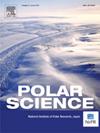格陵兰冰盖表面融化探测的各种微波亮度温度产品和方法评估
IF 2
4区 地球科学
Q3 ECOLOGY
引用次数: 0
摘要
微波亮度温度已被广泛用于探测冰盖表面融化状况并了解其时空变化。本文研究了先进微波扫描辐射计-2 (AMSR2)、特殊传感器微波成像仪/探测仪(SSMIS)和印度散射计卫星(SCATSAT-1)三种不同传感器的微波亮度温度产品在格陵兰冰盖(GrIS)表面融化探测中的灵敏度。使用GC-Net AWSs的现场空气温度测量值进行灵敏度和相互比较分析。我们的研究结果表明,与AMSR2 (18 GHz Pcoef = 0.7)和SCATSAT-1 (Pcoef = 0.67)相比,SSMIS的亮度温度(Tb)与空气温度测量的相关性(19 GHz Pcoef = 0.81)更好。然而,有趣的是,由于AMSR2和SCATSAT-1在两个时期的Tb值的异质性,它们独特地区分了融化前和融化后的表面状况。对AWS熔化日的误差分析表明,采用TED方法的SSMIS 19 GHz Tb (Tb/SSMIS/19H)产品给出了最有希望的观测结果。在融化季节,根据海拔、位置和频率的不同,在不同的AWS站点上观察到Tb值的广泛变化。在我们的研究期间,使用Tb/SSMIS/19H for TED方法,我们观察到2019年极端融化事件的最高融化范围面积(~ 112万平方公里),其次是2021年的另一个融化事件,当时它高达~ 102万平方公里。本文章由计算机程序翻译,如有差异,请以英文原文为准。
Assessment of various microwave brightness temperature products and methods for surface melt detection over Greenland ice sheet
Microwave brightness temperature have widely been used for the detection of the ice sheet's surface melt conditions and understanding their spatio-temporal variability. In this study, we investigated the sensitivity of microwave brightness temperature products from three different sensors, namely, Advanced Microwave Scanning Radiometer-2 (AMSR2), Special Sensor Microwave Imager/Sounder (SSMIS) and Indian scatterometer satellite (SCATSAT-1) for surface melt detection over the Greenland ice sheet (GrIS). In-situ air temperature measurements from GC-Net AWSs were used for sensitivity and inter-comparison analysis. Our findings show that brightness temperature (Tb) from SSMIS better correlates (Pcoef = 0.81 for 19 GHz) with air temperature measurements in comparison to AMSR2 (Pcoef = 0.7 for 18 GHz) and SCATSAT-1 (Pcoef = 0.67). However, interestingly, AMSR2 and SCATSAT-1 uniquely discriminated the surface conditions during pre- and post-melt period, due to their heterogeneity in Tb values during the two period. Error analysis with respect to AWS melt days shows that SSMIS 19 GHz Tb (Tb/SSMIS/19H) products with TED method giving the most promising observations. A wide variability in Tb values is observed during the melt season across the various AWS sites depending upon the elevation, location and frequency. During our study period, using Tb/SSMIS/19H for TED method, we observed the highest melt extent area for the extreme melt event in year 2019 (∼1.12 million km2), followed by another melt event year 2021 when it went as high as ∼1.02 million km2.
求助全文
通过发布文献求助,成功后即可免费获取论文全文。
去求助
来源期刊

Polar Science
ECOLOGY-GEOSCIENCES, MULTIDISCIPLINARY
CiteScore
3.90
自引率
5.60%
发文量
46
期刊介绍:
Polar Science is an international, peer-reviewed quarterly journal. It is dedicated to publishing original research articles for sciences relating to the polar regions of the Earth and other planets. Polar Science aims to cover 15 disciplines which are listed below; they cover most aspects of physical sciences, geosciences and life sciences, together with engineering and social sciences. Articles should attract the interest of broad polar science communities, and not be limited to the interests of those who work under specific research subjects. Polar Science also has an Open Archive whereby published articles are made freely available from ScienceDirect after an embargo period of 24 months from the date of publication.
- Space and upper atmosphere physics
- Atmospheric science/climatology
- Glaciology
- Oceanography/sea ice studies
- Geology/petrology
- Solid earth geophysics/seismology
- Marine Earth science
- Geomorphology/Cenozoic-Quaternary geology
- Meteoritics
- Terrestrial biology
- Marine biology
- Animal ecology
- Environment
- Polar Engineering
- Humanities and social sciences.
 求助内容:
求助内容: 应助结果提醒方式:
应助结果提醒方式:


